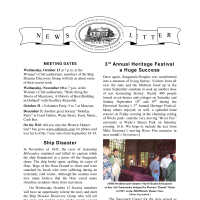SDHS Newsletter - Sept. 2004

2009.41.14
SDHS PublicationsSDHS Events
Winthers, Sally
Oct 2004
119 C CDs Presentations/Programs
Sweeney, Michael Sampson 1947-2020Milwaukie (ship) 1842
"Dusk on Old Kalamazoo" by Michael Sweeney Dusk on old Kalamazoo, dusk as dusk has always been. Melancholy Kalamazoo. Reflections of light and shadow excite the memory. Misty Kalamazoo, speaks from the ancient past to the present and long after our time is through. Timeless Kalamazoo, back when time was only time. Only the sun and moon. Only the trees and the seasons. Only the ebb and flow. Ancient time when the river was much wider and deeper, as evident by the distant high banks left by the receding river. Probing Kalamazoo, perhaps disturbing ancient arrowheads or a tool cut from stone, an old chunk of lumber schooner or a blackened piece of bone. And maybe, they are equal to an old Bohemian beer bottle, some chunk of charred Pavilion dock, a frayed woven basket handle or tongs that once carried the ice block. Genealogical Kalamazoo. Their heirs are chuckling and hiding in the reeds. No tepees or buckskins. No address or phone numbers, no way to contact them at all, yet they are there by our endeavor to understand a past we do not know. Transcending Kalamazoo, to aspire to that which we do not know. Always shrouded in the fears of mortality, never to be satisfied, always something more, always better, a greater life somewhere else; a happy hunting ground, a perfect heaven. The forgiving Kalamazoo, errors of cutting too much timber, dumping too much oil, resin and toxins, too much hunting and fishing. Yet wounded and a bit roughed up, she is still here with open arms marked by her beautiful swans swaying back and forth in elegant, remitting rhythms. On the ancient Kalamazoo, the stillness of the nightshade is upon it. The river is under the tent. The leaves and lilies push their way to the shore. Water moves, words move, music moves. But only in time. Words after speech reach into the silence. Only by the form, the pattern can water, or words or music reach the stillness saying: Before the beginning and after the end. And all is always now. "That which is only living, can only die." Moving perpetually in its stillness. Not the stillness of the violins, or the words or the last note. Not that only, but the co-existence. Or say that the end precedes the beginning. And the end and the beginning were always there. Before the beginning and after the end. And all is always now. At times the river is strained cracked and sometimes broken under the burden, under the tension, slip, slide, perish. Decay with imprecision, will not stay in place. Will not stay still. Shrieking voices, scolding words, mocking music will sometimes assail her. She is most attacked by the voice of temptation, the voice of fear, the voice of ignorance, all cowering in the shadows of selfish mortality. The detail of the pattern is movement. Desire in itself is movement, not in itself desirable. Love is itself unmoving, only the cause and end of movement. Timeless and undesiring except in the concept of time. Caught in the form of limitations between un-being and being. Then suddenly a shaft of moonlight exposes moving water of our dear Kalamazoo, and gives rise to the memories of children's hidden laughter in the foliage. At that moment, the still point where spirit transcends thought, it is clear that the end and the beginning were always there. Before the beginning and after the end. And all is always now. It is not the dance of the torch or the lull of the river. Not the stillness of the violins, or the last word or the last note, not that only, but the co-existence that we celebrate. Or say that the end precedes the beginning. And the end and the beginning were always there.
09/21/2009
10/28/2024


